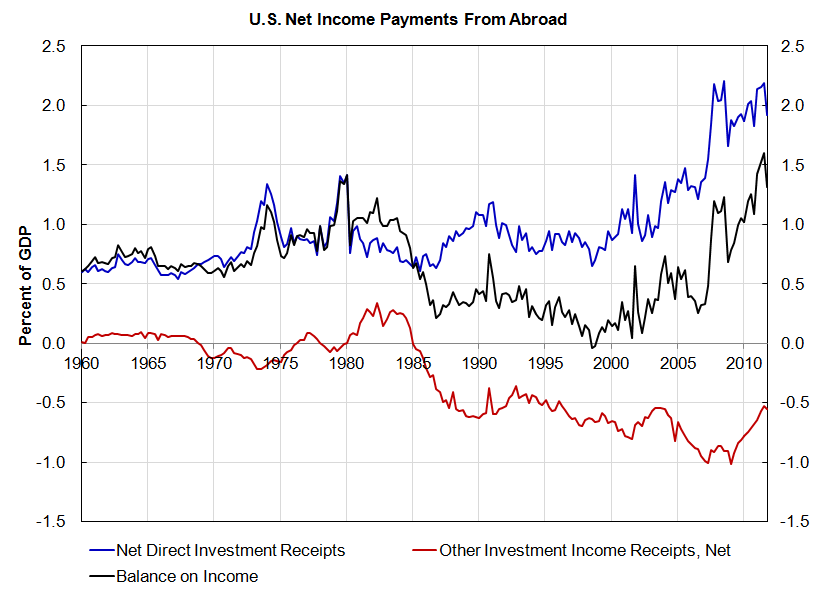The world economy has grown over the last so many years with the United States acting as the importer of the last resort. However, the U.S. current account deficit acts to bleed the circular flow of national income and weakens demand in the States. The nation still grew because of a huge lending boom.
Today, the U.S. Bureau of Economic Analysis came out with the Q4 report on the U.S. International Transactions. According to the release,
The U.S. current-account deficit—the combined balances on trade in goods and services, income, and net unilateral current transfers—increased to $124.1 billion (preliminary) in the fourth quarter of 2011, from $107.6 billion (revised) in the third quarter. Most of the increase in the current account deficit was due to a decrease in the surplus on income and an increase in the deficit on goods and services.
So the current account balance also consists of “income payments from abroad” – a bit of wrong phrasing because all items are income/expenditure flows. The net income payments from abroad continues to surprise analysts because in spite of the net indebtedness position of the United States, this continues to be positive and in recent times has increased! (although it fell the last quarter). Many hold the belief that the United States has lower interest rates and this is the consequence of that. While it is true that interest rates outside the U.S. are in general higher, and there is some truth to the above argument, it gives one the wrong impression that it will always be the case that net income from abroad will always be positive.
The following graph shows that this intuition is misleading. Most of the contribution to the net income is due to direct investments abroad which has made a killing for the private sector and the reverse – direct investment receipts for foreigners has made next to nothing. The remaining – income from financial assets held abroad less interest/dividend paid to foreigners’ holding of U.S. financial assets is already negative!
The red line has reduced in recent times due to lower interest rates in the U.S. presumably. But the more the U.S. continues to run large current account deficits, the deeper the red line will grow – pulling the black line to zero and into the negative territory.
The net income payments from abroad is more a result of the huge killing the U.S. domestic private sector has made abroad than because of lower interest rates. For example, excluding FDI, the data from BEA suggests that the “effective interest rate” on U.S. liabilities was 1.42% in 2010, while that on U.S assets held abroad is 1.65%. This differential will not be sufficient to keep the income payments to foreigners bounded. I used the 2010 data because the International Investment Position is available only till 2010 and the one for end of 2011 will be released only mid-2012.
To understand this, consider the case when the U.S net indebtedness grows to something about 100% of GDP due to the continuous current account deficits – if market forces allow the whole process to go on(!). This is an involved analysis involving some growth assumptions and the fiscal stance in the U.S. and the rest of the world. For example, people frequently forget that a higher growth in the U.S. will also bring in higher current account deficits. But it can easily be shown that the red and the black lines above grow into a negative territory if the United States wants to quickly achieve full employment by fiscal policy alone.
Of course the above graph shows that there is a lot fiscal expansion can achieve in the medium term for the United States.
These numbers look “small” and can lead one into believing that “all is well”. And this is another mistaken view. For example if there is a drastic relaxation of fiscal policy by the U.S. government, the current account deficit will soon hit 6-8% of GDP which may require further relaxation of fiscal expansion to compensate the leakage of demand due to the current account deficit and with income payments turning negative due to higher indebtedness, this will turn into an unsustainable path because the current account deficits and net indebtedness will keep increasing relative to GDP. This will need interest rate hikes to attract foreigners but turns the whole process unsustainable unless one believes in the foreign exchange market doing the trick. Also currently the interest rates are low because the Federal Reserve has kept them artificially low and foreigners do not mind holding U.S. dollar assets at this rate. As William Dudley says interest rates will be raised at some point by the Federal Reserve and this will increase payments to foreigners. See this post William Dudley On U.S. Sectoral Balances
Of course, this is not the only scenario and there’s a lot fiscal policy can achieve in the medium term but it is important to keep in mind that something needs to be done with the external sector to bring the external sector in balance to achieve full employment.
Update: corrected some numbers
